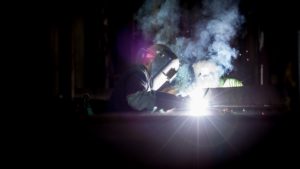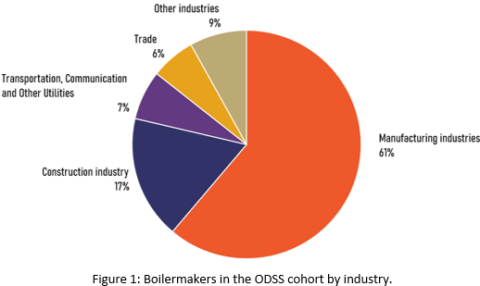Are Boilermakers a High-Risk Trade?
Background
 Boilermakers work in settings, often in confined spaces, that lead to exposure to a variety of occupational hazards including asbestos, welding fumes, dust, exhaust fumes, and noise [1]. Although asbestos is now banned in Canada, boilermakers often work with or around older equipment and materials containing asbestos [2]. Through the fitting and repairing of boilers, workers may be exposed to welding fumes, which are formed during the extreme heat produced by welding. Boilermakers may also be exposed to metal dusts, which can form during tasks such as grinding, scraping, polishing or heating metals. They may also be exposed to wood dust and exhaust fumes from gas or diesel-powered equipment in their work environments [1]. This equipment and other power tools used in their work can also expose boilermakers to hazardous levels of noise [1]. The level of exposure in boilermakers can vary greatly depending on the nature of work, ventilation and PPE, among other workplace factors. There are also many related occupations such as welders, sheet metal workers, and forgers that work in similar environments to boilermakers.
Boilermakers work in settings, often in confined spaces, that lead to exposure to a variety of occupational hazards including asbestos, welding fumes, dust, exhaust fumes, and noise [1]. Although asbestos is now banned in Canada, boilermakers often work with or around older equipment and materials containing asbestos [2]. Through the fitting and repairing of boilers, workers may be exposed to welding fumes, which are formed during the extreme heat produced by welding. Boilermakers may also be exposed to metal dusts, which can form during tasks such as grinding, scraping, polishing or heating metals. They may also be exposed to wood dust and exhaust fumes from gas or diesel-powered equipment in their work environments [1]. This equipment and other power tools used in their work can also expose boilermakers to hazardous levels of noise [1]. The level of exposure in boilermakers can vary greatly depending on the nature of work, ventilation and PPE, among other workplace factors. There are also many related occupations such as welders, sheet metal workers, and forgers that work in similar environments to boilermakers.
Boilermakers are considered a high-risk occupation group, although very few studies have been published on these workers [3-5]. We used Ontario’s Occupational Disease Surveillance System (ODSS) to look at the risk of various health outcomes in boilermakers. The ODSS follows 4467 boilermakers, 93.4% of which are male and work in different industries shown in Figure 1.

Occupational Disease Risks
The following results in Table 1 show the percent increase for risk among boilermakers in a specific industry or occupation compared to all other workers followed in the ODSS.
Increased risk of mesothelioma, lung, and bladder cancers were observed in boilermakers in the ODSS. Mesothelioma is a cancer of the lining of the lungs and other organs that is caused by the inhalation of asbestos fibres [6]. Elevated lifetime risk of mesothelioma has been previously observed in boilermakers and welders [7-8]. Mesothelioma risk for workers in the ODSS is described in further detail in de Bono et al. 2021. Boilermakers are at risk for lung cancer through exposure to asbestos, welding fumes, coke oven emissions, diesel engine exhaust, environmental tobacco smoke, silica, bioaerosols, nickel, and hexavalent chromium Among boilermakers in construction, those in general contracting had a 117%* increased risk and those in special trade contracting had a 68% increased risk for lung cancer. Diesel engine exhaust exposure may also increase the risk for bladder cancer in these workers, which has been previously reported [9-11].
Boilermakers also have increased risks for asbestosis and chronic obstructive pulmonary disorder (COPD) in the ODSS. Boilermakers are at risk for asbestosis through exposure to asbestos [6]. They are at risk for COPD through various exposures such as asbestos, diesel exhaust, welding fumes, and wood dust exposures [12-13]. One study estimated that reduction of exposure to asbestos, diesel exhaust, metal fumes, and wood dust in construction workers would prevent one in ten deaths due to COPD, regardless of other risk factors [13]. A national building trades screening program in the US found a lifetime risk of developing COPD to be 12.3% for boilermakers [14].
| Disease Outcome for Boilermakers in the ODSS | Increased risk |
| Asbestosis | 896%* |
| Mesothelioma | 233%* |
| Lung cancer | 42%* |
| Boilermakers within the construction industry | 82%* |
| COPD | 19% |
| Boilermakers within the metal fabricating industry | 44%* |
| Boilermakers within the construction industry | 64%* |
| Bladder cancer | 12% |
| Boilermakers within the metal fabricating industry | 46% |
| Boilermakers within the construction industry | 66% |
| *Statistically significant (α=0.05) | |
Similar to boilermakers, related occupations of welding including flame cutting, forging, and metalworking-machine operators also showed increased risks for asbestosis, mesothelioma, lung cancer, and bladder cancer in the ODSS.
Prevention and Future Research
It is an employer’s responsibility to conduct hazard assessments and keep workers safe by implementing effective solutions using the hierarchy of controls. More concise and detailed best practice documents are needed to inform boilermakers of the workplace hazards they are exposed to.
Prevention and hazards information for workers and a diagnostic toolkit for primary health providers can be found through the Construction Safety Association of Ontario. Additional information for workers can be found through the International Brotherhood of Boilermakers Canada.
Further research on disease risks and occupational exposures among boilermakers is needed given that the current existing evidence is limited, although new findings have been identified in the ODSS. Future studies can help to better understand the unique exposures of boilermakers and provide guidance for safer work environments for boilermakers.
References
- Occupational Health Risks- Boilermakers. Construction Safety Association of Ontario. N.d.
- CAREX Canada. Asbestos Profile.
- Beaumont JJ, Weiss NS. Mortality of welders, shipfitters, and other metal trades workers in boilermakers Local No. 104, AFL-CIO. Am J Epidemiol. 1980 Dec 1;112(6):775-86.
- Mukherjee S, Rodrigues E, Aeschliman DB, Houk RS, Palmer LJ, Woodin MA, Weker R, Christiani DC. Urinary metal and polycyclic aromatic hydrocarbon biomarkers in boilermakers exposed to metal fume and residual oil fly ash. Am J Ind Med. 2005 Jun;47(6):484-93.
- Hauser R, Eisen EA, Pothier L, Lewis D, Bledsoe T, Christiani DC. Spirometric abnormalities associated with chronic bronchitis, asthma, and airway hyperresponsiveness among boilermaker construction workers. Chest. 2002 Jun 1;121(6):2052-60.
- International Agency for Research on Cancer (IARC). Arsenic, Metals, Fibres, and Dusts. IARC Monographs on the Evaluation of Carcinogenic Risks to Humans Vol. 100C (2012).
- Soeberg MJ, Leigh J, van Zandwijk N. Malignant mesothelioma in Australia 2015: Current incidence and asbestos exposure trends. J Toxicol Env Health, Part B. 2016 Aug 17;19(5-6):173-89.
- MacLeod JS, Harris MA, Tjepkema M, Peters PA, Demers PA. Cancer risks among welders and occasional welders in a national population-based cohort study: Canadian census health and environmental cohort. Saf Health Work. 2017 Sep 1;8(3):258-66.
- International Agency for Research on Cancer (IARC). List of Classifications by cancer sites with sufficient or limited evidence in humans, IARC Monographs Volumes 1-127 (2020).
- Boffetta P, Silverman DT. A meta-analysis of bladder cancer and diesel exhaust exposure. Epidemiology. 2001 Jan 1:125-30.
- Gaertner RR, Trpeski L, Johnson KC. A case–control study of occupational risk factors for bladder cancer in Canada. Cancer Cause Control. 2004 Dec;15(10):1007-19.
- Omland Ø, Würtz ET, Aasen TB, Blanc P, Brisman J, Miller MR, Pedersen OF, Schlünssen V, Sigsgaard T, Ulrik CS, Viskum S. Occupational chronic obstructive pulmonary disease: a systematic literature review. Scand J Work Env Hea. 2014 Jan 1:19-35.
- Bergdahl IA, Torén K, Eriksson K, Hedlund U, Nilsson T, Flodin R, Järvholm B. Increased mortality in COPD among construction workers exposed to inorganic dust. Eur Respir J. 2004;23(3):402-6.
- Ringen K, Dement J, Welch L, Dong XS, Bingham E, Quinn PS. Risks of a lifetime in construction. Part II: Chronic occupational diseases. Am J Ind Med. 2014 Nov;57(11):1235-45.
The Occupational Disease Surveillance System (ODSS) Surveillance Alerts provide brief summaries of occupational exposures and disease risks across different industries and occupational groups. The aim of these alerts is to highlight new or emerging issues detected through occupational disease surveillance. At this time the ODSS includes workers from 1983-2014 and follows their health outcomes until 2016. This alert reflects only the diseases currently tracked within the ODSS. The system is updated and expanded on an ongoing basis.
More information about the ODSS including data sources, methods and detailed results can be found at ODSP-OCRC.ca and OccDiseaseStats.ca.
